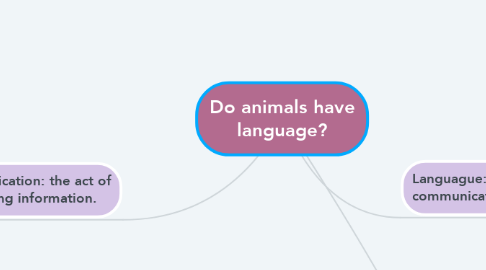
1. Communication: the act of exchanging information.
1.1. Animal communication is a complex system based on signals, which can include visual; auditory, or sound-based; chemical, involving pheromones; or tactile, touch-based, cues.
1.1.1. Smell
1.1.1.1. Pheromones - Chemical
1.1.1.1.1. Example: Ants use pheromones to communicate their social status.
1.1.2. Auditory cues
1.1.2.1. Calls
1.1.2.1.1. Example: prairie dogs use their alarm calls to indicate the predator's size, shape, speed and even for human predators, what the person ir wearing and if he’s carrying a gun.
1.1.2.2. Sound patterns
1.1.2.2.1. Dolphins use whistles to identify age, location, names, and gender. They can also understand some grammar in a gestural language researchers use to communicate with them.
1.1.3. Visual cues
1.1.3.1. Gestures
1.1.3.1.1. Great apes, like chimps and gorillas, are great communicators, too. Some have even learned a modified sign language.
1.1.3.2. Camouflage
1.1.3.2.1. Cuttlefish use pigmented skin cells called chromatophores to create patterns on their skin that act as camouflage or warnings to rivals.
1.1.3.3. Movements
1.1.3.3.1. Honeybees perform complex dances to let other bees know the location and quality of a food source.
1.1.3.3.2. Crabs wave their claws at each other to signal that they’re healthy and ready to mate.
1.2. Animal communication is related to issues of immediate importance and it is essential to their survival: obteining mates, establishing dominance of defending territory, coordinating group behaviors, caring for young.
1.3. Animals produce a particular behavior in response to a particular stimulus or noise, but do not actually understand what the words means.
2. Human language and animal communication aren't entirely different but exist on a continuum.
3. Languague: The system of human communication.
3.1. Human communication stands alone due to the powerful combination of: Grammar, productivity, discreteness, and displacement.
3.1.1. Grammar: it is a complex system of rules that indicate us how to combine such discrete units in our language.
3.1.2. Productivity: it refers to the ability to produce and understand an infinite number of messages by combining the units differently.
3.1.3. Discreteness: language is built up from discrete units (signs, words, sounds) that can be combined in order to communicate new ideas.
3.1.4. • Displacement: it refers to the ability to communicate about things or events that are distant in time or space.
